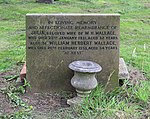William Herbert Wallace
William Herbert Wallace (29 August 1878 – 26 February 1933) was an Englishman convicted in 1931 of the murder of his wife, Julia, in their home in Wolverton Street in Liverpool's Anfield district.On finishing his apprenticeship he obtained a position in Manchester with Messrs Whiteway Laidlaw and Company, outfitters to the British Armed Forces and the Colonial, Indian and Diplomatic Services.[1] All early sources suggested that Julia was approximately the same age as Wallace, but in 2001 James Murphy demonstrated from her original birth certificate that she was actually seventeen years older than he was.During the 1920s, Wallace supplemented his comfortable but mundane existence as a collections agent, working exclusively in the neighbouring Clubmoor district, by lecturing part-time in chemistry at Liverpool Technical College.His hobbies included chemistry, botany, and chess, and in 1928 he learned to play the violin to enable him to accompany Julia, who was an accomplished pianist, in "musical evenings" at their home at 29 Wolverton Street, Anfield.These tests were not introduced as evidence at trial since, ultimately, the Prosecution offered nothing to controvert Wallace's assertion that he had boarded the tram elsewhere, and did not make the phone call.The police formed the theory that a mackintosh, which was inexplicably found under Julia's corpse, had been used by a naked Wallace to shield himself from blood spatter while committing the crime.Examination of the bath and drains revealed that they had not been recently used, and there was no trace of blood there either, apart from a single tiny clot in the toilet pan, the origin of which could not be established, but was alleged to have been the result of inadvertent cross-contamination by the Police.[6][7] After conducting a secret mock-trial in London, which unanimously found Wallace not guilty, the Prudential Staff Union, in a unique act, sponsored his defence.[8] Despite the evidence against him being purely circumstantial, and the statement of a local milk delivery boy—who was certain he had spoken to Julia only minutes before her husband would have had to leave to catch his tram—Wallace was found guilty after an hour's deliberation by the Liverpool jury, and sentenced to death.Many of Wallace's previous customers shunned him; he was subjected to hate mail and physical threats and had to take a clerical job at his employer's head office.His private diaries speak of his anguish at the loss of his wife, and whether they would be reunited in the afterlife, and his growing belief in the guilt of a former colleague, and the fear even that he (Wallace) might be murdered by the same person.Wilkes learned that Goodman's suspect, a man named Richard Gordon Parry,[16] had given the police an alibi for the time of Julia's murder – presumed to be from a woman to whom he was engaged.The son of the Detective Sergeant on the case confirmed to Wilkes that Parry was interviewed by the police as "the prime suspect", his house and car were "turned over", but he appeared to have an "unshakeable" alibi for the time of the crime.Wilkes argues that there was, moreover, no motive or reason for Wallace to kill his own wife, and that he was charged because the immense publicity surrounding the case impelled the police to get a conviction at any cost.However, when Goodman and his friend Richard Whittington-Egan confronted him on his London doorstep in 1966, Parry displayed an astonishingly detailed knowledge of the case and was aware of the deaths of several obscure witnesses connected with it.The new theory, first posited in 2008 by Merseyside-based researcher Rod Stringer, holds that Parry was indeed the brains behind a distraction burglary, which turned to murder when his unknown accomplice was confronted by Julia after rifling the cash box—after first gaining entry to 29 Wolverton Street on the pretext he was “Qualtrough”.









murderLiverpoolAnfieldCourt of Criminal Appeallegal historyPrudential Assurance BuildingMillomCumberlandBarrow-in-FurnessLancashireManchesterMessrsBritish Armed ForcesColonialIndianDiplomatic ServicesCalcuttaShanghaiGuy's HospitalLiberal PartyHarrogateelection agentNorthallertonveterinary surgeonFrenchFirst World Warparliamentary trucePrudential Assurance CompanyClubmoorchemistryLiverpool Technical Collegebotanyviolinpianisttramcarsitting roommackintoshcross-contaminationR v WallaceSt George's Hall, LiverpoolLiverpool AssizesLondonPrudential Staff Unionsentenced to deathquashed the verdictRichard Whittington-EganBromboroughWirralafterlifeuraemiapyelonephritisClatterbridge HospitalAnfield CemeteryNorth WalesDetective SergeantWinifred DukecognateThe Sunday TimesP. D. Jamesblackmaildistraction burglaryRaymond ChandlerMr. Justice WrightDorothy L. SayersJames AgateF. Tennyson JesseJohn BrophyEdgar LustgartenThe Murder RoomJ.B. PriestleyMiscarriages of justiceList of unsolved deathsLlangernywMerseyside PoliceColin WilsonP.D. JamesThe Internet ArchiveYahoo!Edward WinterDaily TelegraphLiverpool EchoGoogle StreetviewClive BrookThe Black MuseumOrson WellesDerek BentleyTimothy EvansMahmood Hussein MattanJonathan RosenheadMurder of Maxwell ConfaitStockwell SixOval FourAndrew EvansLiam HoldenStephen DowningJessie McTavishJudith WardBirmingham SixGuildford Four and Maguire SevenGerry ConlonStefan KiszkoRobert BrownAnthony SteelPaul BlackburnBridgewater FourSean HodgsonTottenham ThreeWinston SilcottErnest BarrieMichael ShirleyCardiff Newsagent ThreeWest Midlands Serious Crime SquadWinchester ThreeEddie BrowningM25 ThreeRaphael RoweCardiff ThreeMichelle and Lisa TaylorLee CleggJonathan JonesVictor NealonSiôn JenkinsDonna AnthonySally ClarkJohn CorcoranSub-postmasters operating the Post Office Horizon computer system